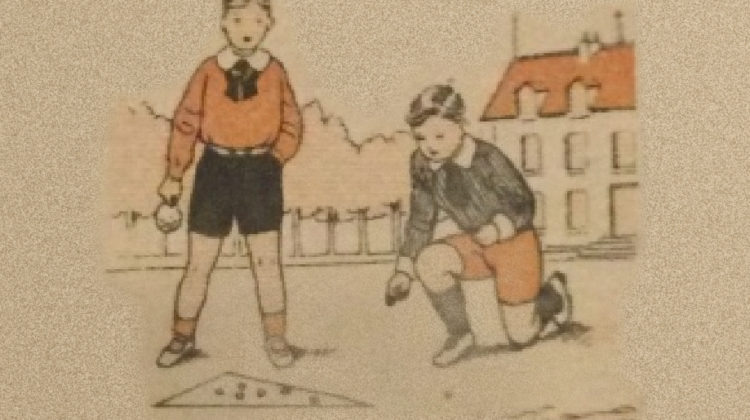
Senior Author: Wendy Leyn, Zonnebeke, Belgium
Deceased, 2024
In our October 2023 post “Circles, Triangles, & Holes” we described how children in different countries tend to draw different patterns on the ground, or in chalk or on cobbles, in which to set up their marble games. In the Americas, for example, our children tend to draw circles of various sizes in which to shoot marbles, while in India the triangle seems preferred. We raised a question in our first “Triangles” story “What role does the social environment play in how children play marbles?” That is, is it because I am American that I draw circles and design my marble game rules to fit them?
Or, in the case of this second look into triangles, is it because I am French that I often play marbles inside triangles? We still wonder exactly what role, if any and how, the culture in which one grows up, or the culture that one adopts as their own, influences the rules of marble play to include the shape of the playing field.
Playing with Piaget’s Marbles
In our first “Triangles” story we studied Piaget to see if he offered clues about the links between specific type games and one’s culture. Unsuccessful at the time, we take a second look in this post. Wendy discovered Piaget’s paper “The psychology of marbles” in the November 1996 issue of The Unesco Courier….[2] Piaget’s opening paragraph is informative: “Children’s games constitute the most admirable institutions. The game of marbles, for instance, contains an extremely complex system of rules which constitute a well-marked social reality, ‘independent individuals’ and transmitted, like a language, from one generation to another.”
Still no real answers as to the influence of one’s culture, to include language and social mores, and the formation of specific rules of marble play such as the use of triangles, holes, circles, crosses, or whatever.
Ok, Then Let’s Just Have Fun & Learn a Bit More About French Triangles! [1]
We decided to meet some exciting people who know a lot about marbles and who are willing to teach us. So, here is a short review of what we learned.
What first attracted our attention to French triangles is this chromograph (chromo) “Games No. 1 Bon-Point Marbles”. We cannot see a pattern of play and we are unsure why a boy is shooting from the side of the triangle. But the second boy has a full bag of marbles, so the game must work.
Try as we may, we have been unable to date this chromo and, since it was issued as an advertisement by Nestlé, which was started in 1866 in Switzerland, we cannot be certain where the lithograph was set and printed.
Chromos
However, we have learned this about chromos: “Chromolithography is the term chosen by the lithographer Godefroy Engelmann to designate his process of lithographic printing in colours (1837), based on colour printing, up to 16 different colours. Each colour was placed on a lithographic stone and the same document was passed from one stone to another with precise markings. This time-consuming, and therefore expensive, process was later replaced by four-colour offset printing.”[3]
But we have been unsuccessful in learning a great deal about this particular card which was used to advertise Nestlé products. Wendy notes that this chromo was included for free with some of the Nestlé merchandise and perhaps chocolate because that used to be fashionable in Europe, a long time ago. He also notes that Chocolate Jacques did that too.
Chocolate Jacques was founded in 1896 in Verviers Belgium. During much of the 20th century, the wrappers of “Jacques” chocolate bars contained collectible chromo cards that could be stored in albums published by the factory.[4]
Wendy also points out that another chocolate maker published chromos. Côte d’Or, which still exists today as a brand, is a remarkably popular chocolate in Belgium. It was founded in 1883 in Schaerbeck, Belgium and the name is taken from the “Gold Coast” which is the old name for Ghana. Ghana produced most of the cacao beans used by the Company.[5]
Corinne Jacquemin [6]
While trying to learn more about the Bon-Point Marbles chromo, we met Corinne Jacquemin, author of Tours les Jeux de Billes or All Marble Games, online. She told us in an email on November 21st that Nestlé Bon-Point, is part of a Games series and it could be inserted into a Nestlé Peter Callier Kohler sticker album (sometimes called an album timbre).[7] Like us, she could not pin down a date. Ms. Jacquemin also told us that she could find no trace of the particular album which contains the Bon-Point from the Games series.
We are unsure whether or not Nestlé published the Peter Callier album timbres, like Jacques published their chromos albums in-house. This card is an early one and we all agree that it was probably published in the 1930-1940s. These cards were popular, both to trade and to build various albums, when they were published and they are, especially the sports ones, still popular today.
While the sports series, especially football, are still extremely popular collectibles, we are left to wonder which games, other than marbles, are included in the “Games” series. We also wonder how many different games are featured.
$261.00!
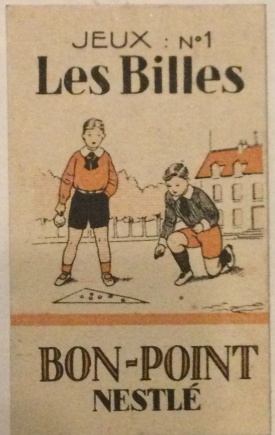
Some of the Peter Callier album timbres are available online. While none of us has found the album containing the marbles card, we do know that some of these albums sell for as much as $261.00!
Jo and Larry have spent hours digging through tons of ephemera for Victorian advertising cards at flea markets, yard sales, and in antique stores. At one time advertisers in Europe and in America published an amazing variety of “soap” and “cigarette” cards.
These featured candies, perfume, Singer sewing machines, cologne, detergent, cigars, farm implements, and something called “eye water”. And this is a short list. We have found a precious few which feature children playing marbles. We don’t think that companies ever made and sold albums in the United States in which to organize and store your cards.
Corinne Jacquemin, Tours les Jeux de Billes, & Piaget
On page 56 of her text, Corinne explains how to set up and play marbles in “Le Triangle”.
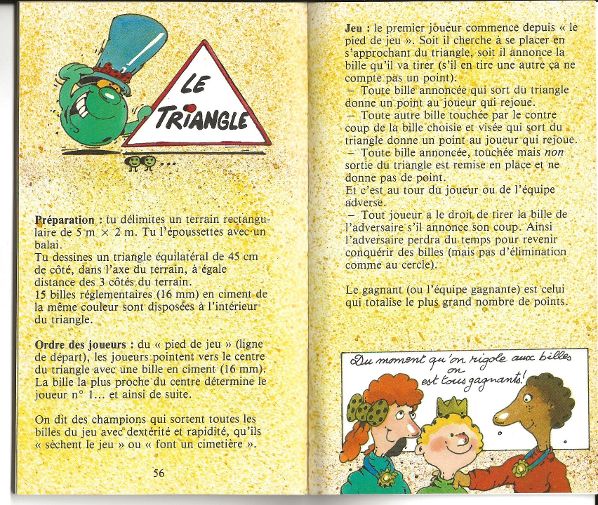
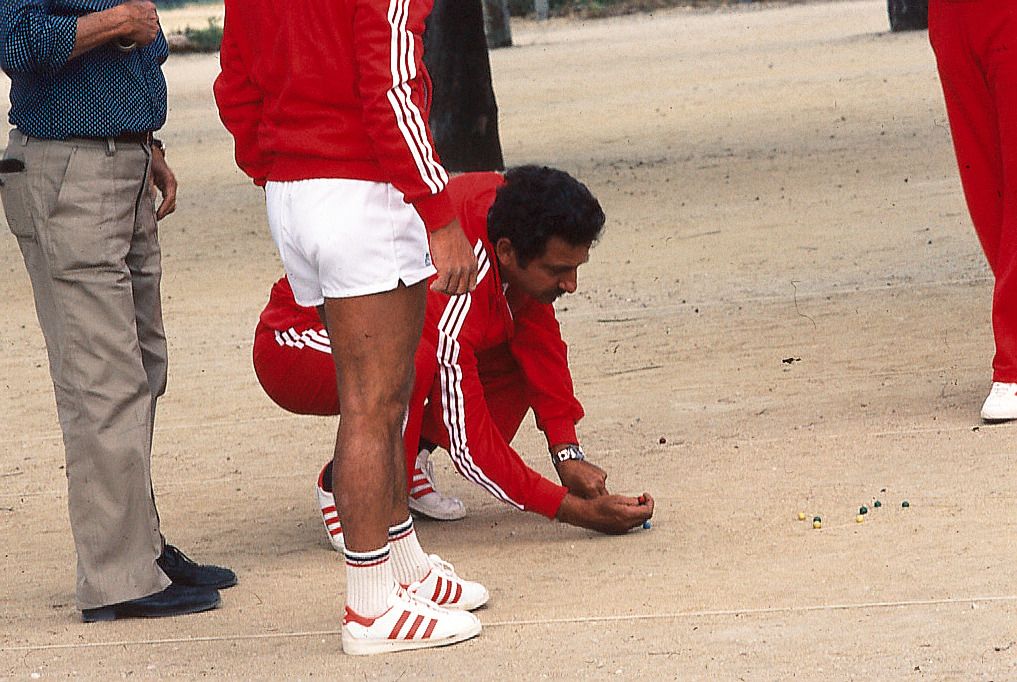
The first paragraph reads:
Preparation: You mark out a rectangular area of 5 m x 2 m [about 16’ X 6½’]. You dust it with a broom.You draw an equilateral triangle with a side of 45 cm [about 17”], in the axis of the land, at equal distance from the 3 sides of the land. 15 regulation balls [marbles] (16 mm: ⅝”) in cement[8] of the same color are placed inside the triangle.
While we are unsure what “regulation marbles” are in this context, this photograph shows the shooter with ⅝” marbles all of a single color. These marbles look very much like “Billes & Traditions” to us; these are a specialized type earthen marble. This photograph is courtesy of Corinne Jacquemin via email. She tells us that it was taken at a French marble tournament on the 17th of July, 1981. She also told us that Raymond Gastaud, the president of the French Federation of Marble Players at the time, participated in the Tournament.
Remember Piaget’s insight into marble rules? “The game of marbles…contains an extremely complex system of rules which constitute a well-marked social reality….” Well, Jacquemin has practically illustrated exactly what Piaget says. She illustrates precisely how children learn to draw triangles! They read the book, or an adult reads it to them, they almost certainly discuss it with both an adult and other children and then the concept is carried forward into physical reality. While it doesn’t explain the “why”—why would the French prefer triangles over some other type playing field— it does address the “how”—how are the rules of play transmitted in French society.
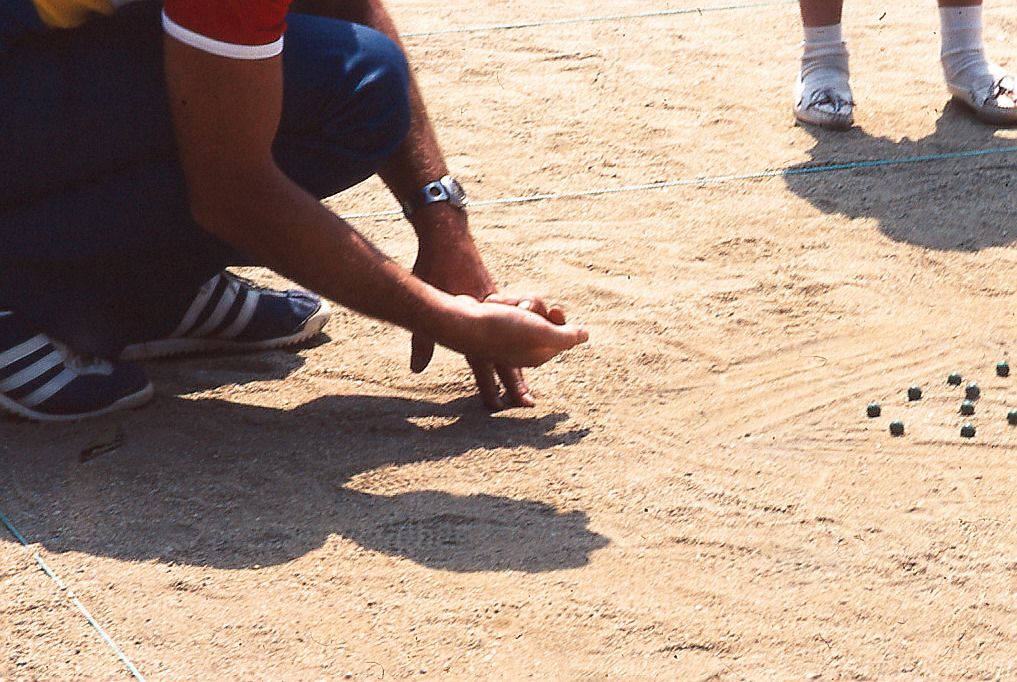
The triangle is perfectly clear in this photograph which is courtesy of Corinne Jacquemin via email.
Wendy’s Sketch: a Visualization of the Rules!
For those of you who are visually oriented, Wendy has drawn a sketch of the playing field described in Jacquemin’s book. One special thing to note: Jacquemin’s writes about the “land” at equal distance from three sides of the equilateral triangle. Wendy delineates this land as terrain in his sketch which may make the playing field a bit more understandable.
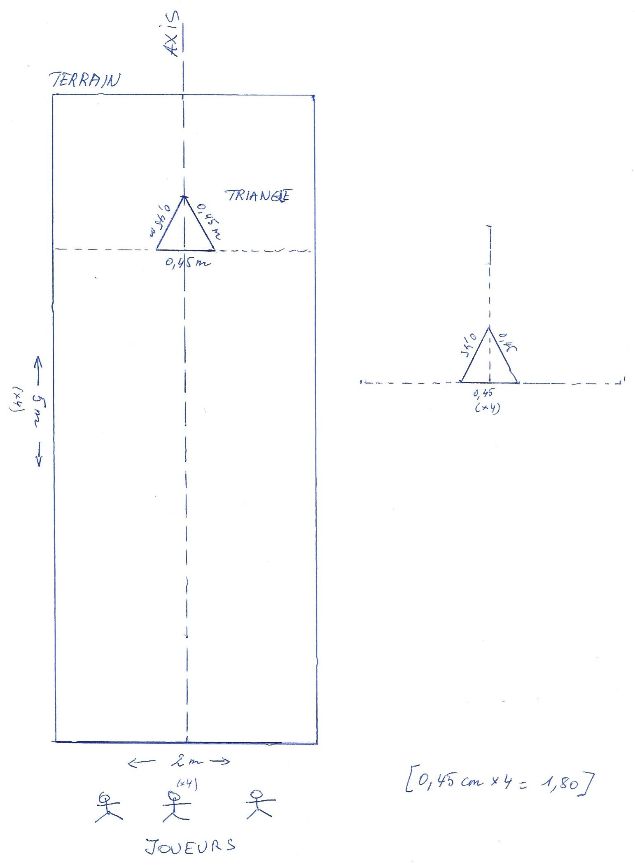
Black and White
The first issue of the French magazine Noir et Blanc was in February 1945. The magazine, known for its black and white cover, focused on the lives of celebrates. It ceased publication in 1971.
While researching this article, Wendy discovered some ephemera which was gifted to him by Christiaan Therry who wrote “It All Started in the Garden” https://thesecretlifeofmarbles.com/it-all-started-in-the-garden/ The materials come from the archives of Bertram M. Cohen.
“Marble Bert” Cohen, who died in 2014, was known throughout the marble world, not only for his collection of 300,000 marbles but for his generous spirit, his willingness to share, and his eagerness to learn and to teach all about marbles.[9] Christiaan tells us that in the 1980s Bert sponsored the Marbles World Championship in Tinsley Green, London. And, in typical fashion, he gifted Christiaan with art glass marbles and books.
The ephemera which Christiaan shared with Wendy includes three pages from the March 25-31 1965 issue of Noir et Blanc. Frankly,1965 seems a long time ago to us! We have included the first page of this story, “Three Men of Marseille Give Their Marbles to the French,” to give you some flavor of the original.
This short story describes the formation of the Union of Marble Players as a sporting federation. After the formation,“strict licensing and rules” were imposed in1965. Wendy describes this event as the “origins and birth of the French triangle championship”.
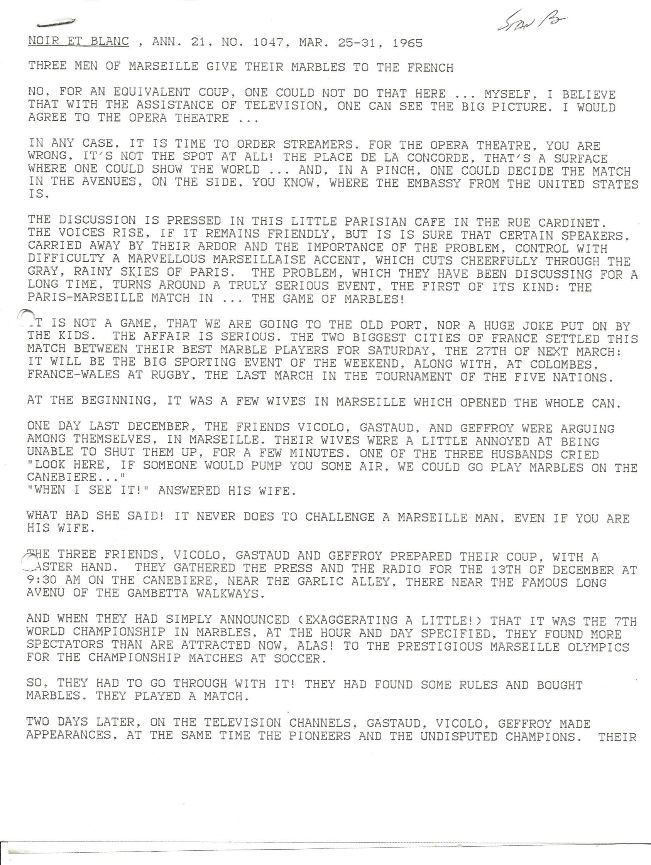
1965 Marble Triangle Rules
We thought that it might be fun to compare the rules of the game as played in 1965 with those provided by Corinne Jacquemin. Wendy points out that “We do not have a text with guidelines from the ‘Fédération francaise des jeux de billes’ on how to play Triangle at the (French) marble players championships. That is, we do not have the formalized rules.
Incidentally Corinne tells us that “The French tournament game is Triangle, a game which is not recognized in other countries”.
While there is little in the Noir et Blanc, we quote what we have on page 2. “The terrain is quickly laid out: 4.3 meters long, 2 m. wide. The starting line 1.1 meters from the base of the terrain, and 2.5 meters from the equilateral triangle of .2 meters, which is found at the axis of the terrain. The marbles are of glass, their required diameter is 16 mm.”
Jacquemin: “…rectangular area of 5 m x 2 m [about 16’ X 6½’].” Very close indeed! “You draw an equilateral triangle with a side of 45 cm [about 17”], in the axis of the land, at equal distance from the 3 sides of the land. 15 regulation balls [marbles] (16 mm: ⅝”) in cement of the same color are placed inside the triangle.”
Ok, there are fundamental differences. The Noir et Blanc, for example, plays with glass ⅝” while Jacquemin recommended earthenware. And one notable difference is that the 1965 article doesn’t mention how many marbles are to be put into play.
After some reflection Wendy supposes that the triangle rules and field as mentioned in the “Noir et blanc” article are a quick and first improvisation of rules. The project as described in the article was really art and flying work under time pressure. For an introduction to playing with marbles in France using current rules, see https://www.lembach.fr/ecole/wp-content/uploads/2021/10/Les-billes.pdf .
Also Wendy is not sure that the reporter was just in his interpretation and description of the play (on a petanque field!) in 1965. Maybe it is safer to adhere to the (later more developed?) rules as described later by Corinne Jacquemin (1982, 1987) in her book “Tous les jeux de billes” and Jean-Paul Benoit (2012) in the text “Jeux de billes”.[10]
Exact details and comparisons are not necessary. The point is that it is through rules and the “formalization” of marble play that concepts such as fair play, organization, cooperation, and how one plays the game — to include with triangles, in this case — are passed down from one generation to the next. Children play marbles unsupervised and they often modify and transform the game, but they play within a broad organizational design called rules and regulations. These rules and regulations come from and are modified by the society in which the children live. Without some rules there could no marble games at all.
Esther Bovin
A recent source of information which Wendy found is the book Jeux de Billes (Marble Games).[11]
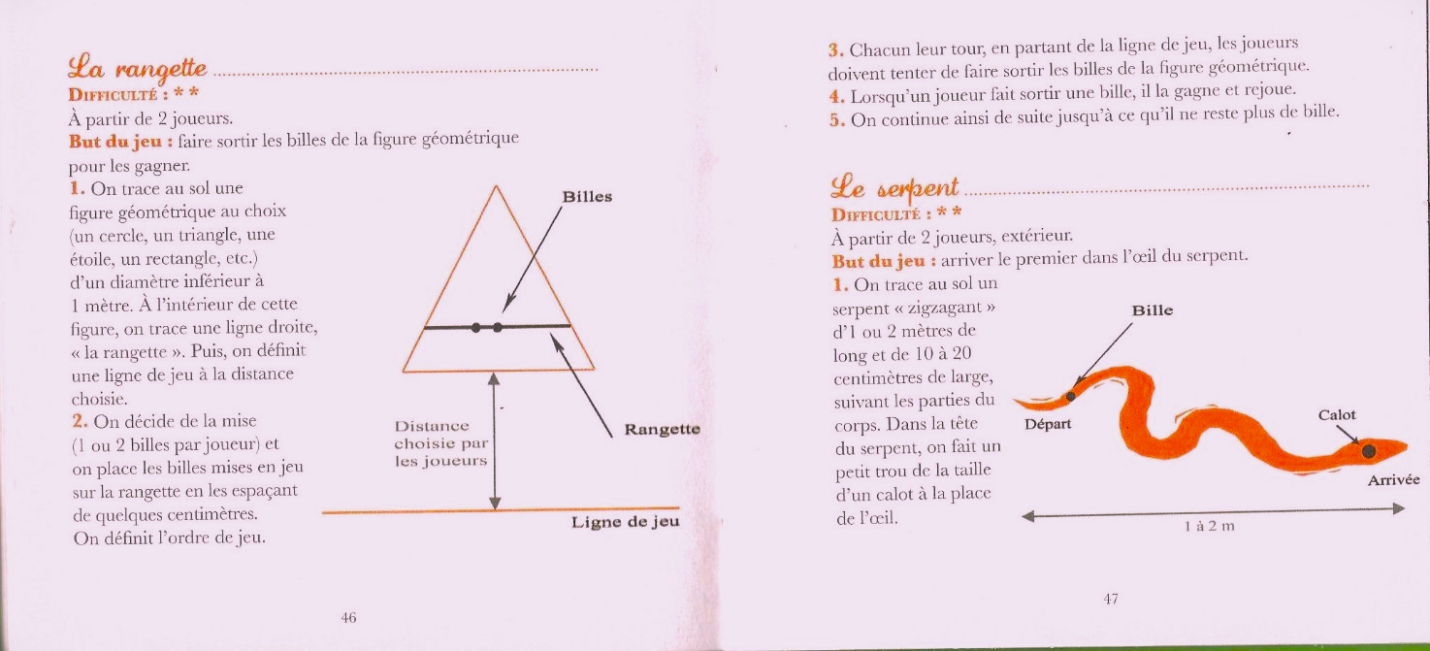 La
La
La Rangette For Two Players
We regret that Bovin doesn’t tell us what age is most appropriate for children to learn and enjoy this game.
The aim of the game is straightforward: make the balls come out of the geometric figure to win them.
The first step is to draw a geometric figure of your choice on the ground. While Bovin lists a triangle as a first choice, she also includes a circle, rectangle, and something we would love to see children play: a star!
A diameter is a straight line passing from side to side through the center of a body or figure, especially a circle or sphere. Bovin tells us the diameter in this game should be less than 1 meter which is a bit more than 39 inches. As for as the diagram in this illustration, Bovin writes that children should draw a diameter (simply a straight line) inside the figure of choice. This line is “the rangette.”
Finally, we decide on whether to play one or two marbles per player, the order of play, and then we place the marbles on the rangette as shown in the illustration. We place each marble on the rangette just less than one-half inch apart. Then we decide the order of play.
Rules. Procedure. Order of play. Number of marbles each. The answer to our question: how do children within a given culture learn to play marbles in a particular way and using a distinct field of play? is becoming more clear. Through rules established within the culture and using conventions passed down by others (adults) within the culture. Marble play is expressed through rules and regulations.
One more important writer on the topic
As usual, Wendy has done a remarkable job in reviewing the literature, emailing and talking to experts worldwide about the topic. We could never share even half of what he has learned on whichever topic we are exploring.
Jean-Paul Benoit & Marble Games
One last important source: Les jeux de billes (Marble Games) a PDF from Jean-Paul Benoit, Président de l’association Billes du Val de Drôme (President of the Marble Association of the Drôme Valley).[12] Drome is a Department in the Auvergne-Rhône-Alps of southwestern France. This is a breathtaking region and we traveled south through the Department on our journey from Paris to Nice. We will never forget it.
“Rhône-Alpes is the southernmost department in the Auvergne-Rhône-Alpes region of Southeastern France. It was a région of France and as a région it encompassed the southeastern départements of Loire, Rhône, Ain, Haute-Savoie, Savoie, Isère, Drôme, and Ardèche. In 2016 the Rhône-Alpes région was joined with the région of Auvergne to form the new administrative entity of Auvergne-Rhône-Alpes.”[13]
On page two of the Marble Games PDF is a section called “Description”. Benoit writes that
“The game of marbles is very widespread throughout the world, and commonly associated with children who play it. [Children] practice in the schoolyard. It is played by two people, one against the other and consists, in its … basic technique called classic, putting as many marbles as possible into a hole using your finger.
…[Taking ] turns, the players located 7.5 meters from the center of the target, throw their balls [shoot their marbles?] one by one at the closer to a hole dug in the ground. The latter should measure 9 to 11 centimeters in diameter. Afterwards, they try to put their marbles in the hole. A success allows you to play again. The winner is the one who has put the most balls into the hole first.”
OK. We’re a bit surprised that Benoit is writing about “rolley hole”, but he is setting up what he describes as “classic” which may be the “historical” way that children played marbles in France. The type marble game played really doesn’t matter. The fact is established that historically children have played marble games inside some set of rules and regulations.
On page three of the PDF Benoit lists a number of different marble games and how to play them. These marble games include: One to five; the piquette; and the rapprochement. And, of course, “the ring.”
He says this about the ring or circle:
“The ring is in a way the Anglo-Saxon version of the triangle; players must send their marbles onto a circular board containing 49 other marbles, with the aim of bringing out these from the game board and thus pocket them.” “Anglo Saxon” in this case refers to the British, Americans, Canadians, and Australians. Jo and Larry found this insight especially informative. We always thought about the French triangle as their form of circle; while the French think of the circle as derivative of the Triangle!
And, finally, as for the triangle, Benoit writes this:
The triangle is a drawing on the ground, in which 15 earthen balls measuring 16 millimeters [⅝”] in diameter are inserted. These balls constitute the starting bet. The players must, using their marbles, make the balls come out of the triangle to pocket them. A player whose ball remains in the triangle must put back all the marbles won previously and play again when their turn comes. The same game can take place in a square or a circle, hence the diversity of names given to this variant of game.”
Finally, there is an anecdote which Wendy found and which we wish we could share It is a short story about playing triangle marbles in school in Belgium in 1948 – 1949. The story also has a cute sketch you might want to see.[14] We will leave it to you to check out if interested.
Last Thoughts
We close this story with a paper written by Neven N. Cetin. Dag, Emine Turkkman, and others. The paper “Children’s only profession: Playing with toys” is set within the broad parameters of Piaget. While it does not mention marbles specifically, it does confirm many of our ideas on play. “Playing is a social activity. With games and toys, the child steps out of his inner world and starts communicating with the outside world. Through the game, it is learned to greet, introduce oneself, participate in the game, respect the people around, wait their turn, share, and gain the ability to solve problems, obey the rules, and defend their rights against others.”[15]
Marbles games have fundamental (and sometimes complicated) rules and procedures. This framework is established, formally or informally, by the society in which the child is raised. And in France this means that a child is or was taught to place triangle as a preference over the “Anglo Saxon” versions!
Wendy observes that “I think in the year 2023 the triangle marble game has lost significance in France, it is history. There are some other marble games and championships, outdoor and indoor who are in the picture.” Jo and Larry would regret it if the triangle loses favor. But, regardless, it is now a classic game and it will remain a vibrant part of the French culture. But there is more to find on the internet, and marble playing is still alive and has a healthy future in “la douce France”.
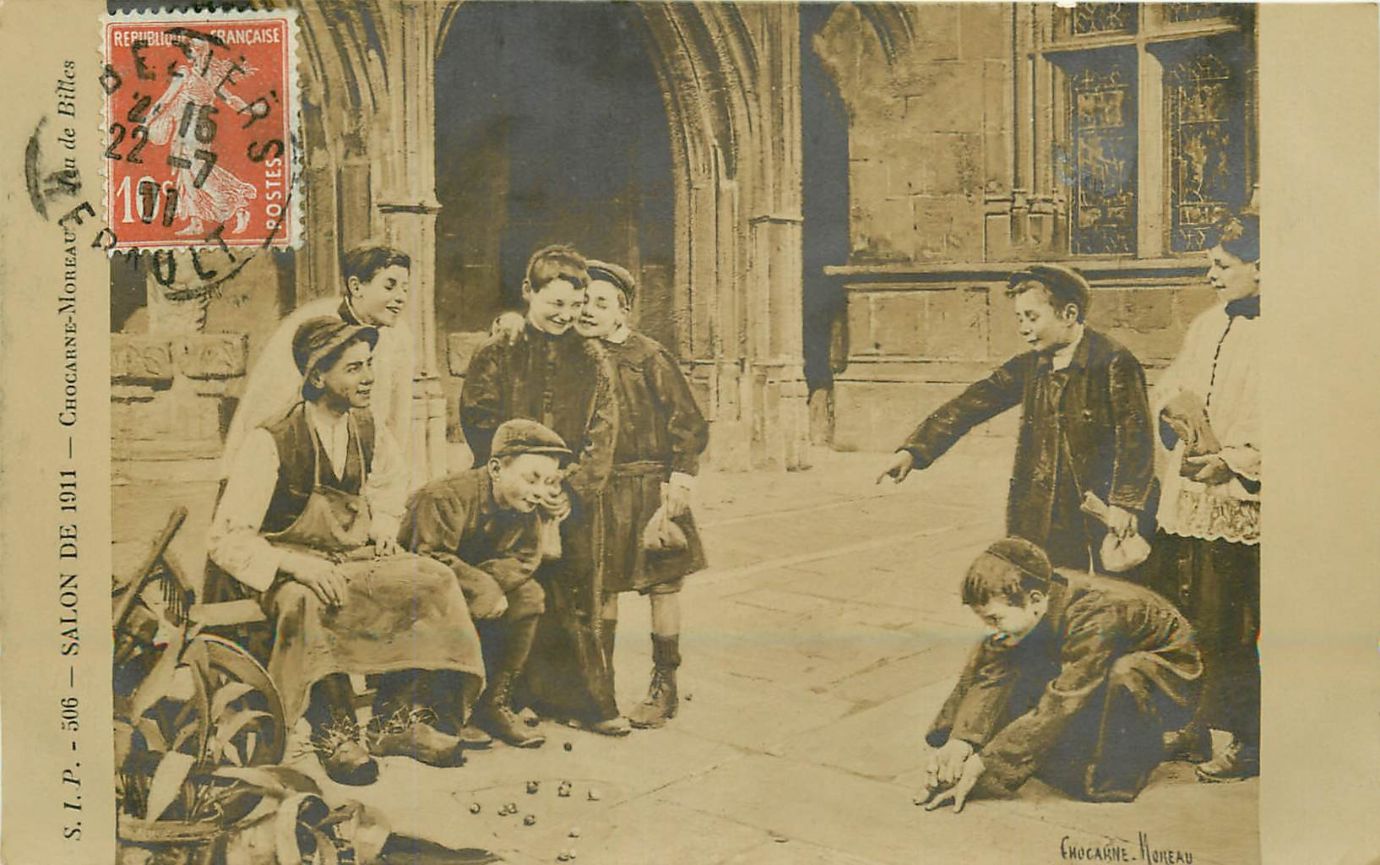 Photo courtesy Wendy Leyn, Zonnebeke, Belgium
Photo courtesy Wendy Leyn, Zonnebeke, Belgium
- NOTE: The authors have made every good faith effort to identify all copyright holders of the photographs used in this Post. However, if you do know of a photograph of which you are the copyright holder, and you have not granted us permission for our use, then please do contact us @ https://thesecretlifeofmarbles.com/contact-us/ ↑
- Piaget, Jean. “The Psychology of Marbles.” The UNESCO courier: a window open on the world, 49, 11, p. 49-50. @ https://unesdoc.unesco.org/ark:/48223/pf0000104900/ 12/11/2023↑
- Chromolithography – Wikiworld Encyclopedia (wikimonde.com) (12/11/2023) You may also want to check “The ‘Chromos’: colorful and playful images of the 1870s-1920s” @ https://www.surlesbranchesdupommier.com/2019/07/les-chromos-images-colorees-et-ludiques.html (12/11/2023) and “Collecting advertising images” 12/11/2023↑
- https://en.wikipedia.org/wiki/Chocolat_Jacques/ 12/11/2023 ↑
- https://en.wikipedia.org/wiki/C%C3%B4te_d%27Or_(chocolate) (12/16/2023). You can see samples of their chromos @ https://www.delcampe.net/fr/collections/chromos/chocolat/cote-d-or/ 12/17/2023 ↑
- Tous les Jeux de Billes Ed. Buissonnières, 1982. ↑
- Contacts at Societe Nestlé, albums department, 6 avenue Portalis 75008. Paris. ↑
- Email from C. Jacquemin: “What I call cement is in fact this mixture of hot grains of sand and water which, mixed in the cement, ended up after three hours forming a ball, after 7 hours forming a cap. These are the notes I took during my visit to the Barral Establishments. The Barral family was famous in France and they have an interesting history. …”Founded in 1876 in the Drôme region by Alexandre Barral, the family business began by manufacturing stone marbles, before starting in 1928 to produce terracotta marbles. This ceased in 1935 and during the Second World War…. Faced with competition from glass beads of Asian or American origin, the Barrals were forced to close the factory in 1984. From 1985 to 1998, the marble remained present in the region through the museum dedicated to it, operated by the Guilhot family, owners of the building. In 1998, Mr. Desbois revived the production of earthenware logs by creating the company Billes et Traditions, but economic difficulties forced him to close at the end of February 2009. The factory was bought (machinery and know-how) by Mr. Yves Renou and has been located near Limoges, in Saint-Maurice-les-Brousses, in Haute-Vienne, since March 2009. …Within the original building in Mirabel-et-Blacons, the marble museum is now managed by the association “L’Usine à Billes”, which aims to rehabilitate it and renovate the building. It traces the history of the Drôme factories (Saoû, Cobonne and Mirabel-et-Blacons) which were the main French marble factories to be played.” Marble game – Wikipedia, the free encyclopedia (12/16/2023) Note that Wendy was diligent in finding more information on this Company. ↑
- We have selected a reference for Bert which does gives some impression of what he was like and what the marble world is missing. It is @ The E-Sylum https://www.coinbooks.org/esylum_v17n53a08.html (12/19/2023). Incidentally, Corinne Jacquemin met Bert at his home once in Boston and she was fortunate enough to share a long correspondence with him.↑
- Free to read on the Internet as “Fiche type d’ inventaire du patrimoine culturel immateriel de la France, see also the references on https://fr.wikipedia.org/wiki/Jeu_de_billes. ↑
- Bovin, Esther. Marble Games. Hugo Youth, 2013, 56 pages. “La rangette” is on page 46. The book is available on Google @ https://books.google.com/books/about/Jeux_de_billes.html 12/19/2023 ↑
- @ https://www.culture.gouv.fr/Media/Thematiques/Patrimoine-culturel-immateriel/Files/Fiches-inventaire-du-PCI/Les-jeux-de-billes/ (12/21/2023) Also https://simple.wikipedia.org/wiki/Dr%C3%B4me/ 12/21/2023 ↑And https://www.britannica.com/place/Rhone-Alpes/ 12/21/2023 ↑
- From: And If Waste to Bills? The Petite Gazette anecdote and unusual The Petite Gazette of 31 October 2012 @ https://lapetitegazette.net/2016/04/10/et-si-on-jouait-aux-billes/ (12/21/2023) Published by petitgazette 12/8/2023 An online article by Karine Michel, “Game: The game of marbles (Drôme) echoes the work of Benoit. @ https://pci.hypotheses.org/1708/ 12/21/2023 ↑
- Cetin Dag N, Turkkan E, Kacar A, Dag H. “Children’s only profession: Playing with toys.” North Clin Istanb 2021;8(4): 414–420, page 417. ↑

